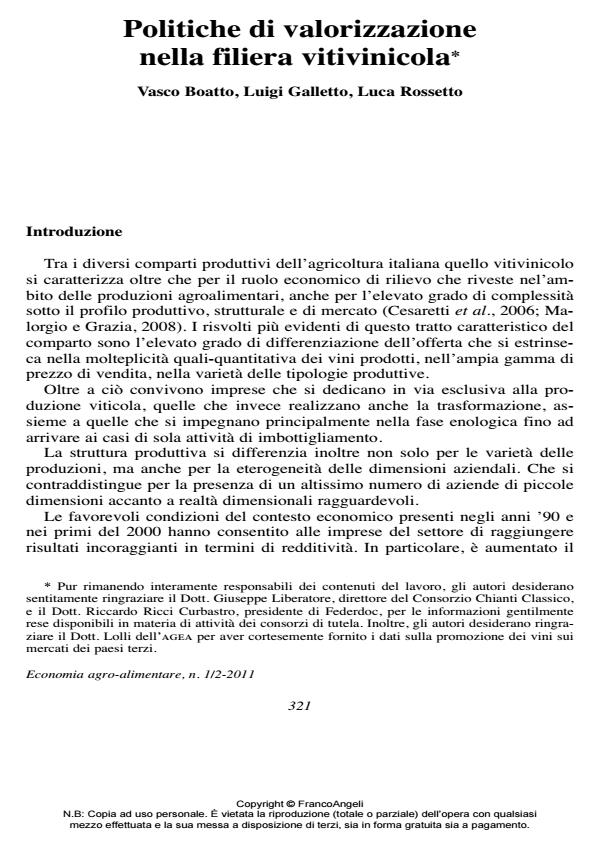Promotion policies in the wine market
Journal title ECONOMIA AGRO-ALIMENTARE
Author/s Vasco Boatto, Luigi Galletto, Luca Rossetto
Publishing Year 2011 Issue 2011/1-2
Language Italian Pages 45 P. File size 658 KB
DOI 10.3280/ECAG2011-001015
DOI is like a bar code for intellectual property: to have more infomation
click here
Below, you can see the article first page
If you want to buy this article in PDF format, you can do it, following the instructions to buy download credits

FrancoAngeli is member of Publishers International Linking Association, Inc (PILA), a not-for-profit association which run the CrossRef service enabling links to and from online scholarly content.
The wine market is strongly differentiated according to consumer’s expectations as well as firm’ strategies while the competitiveness among wine companies has increased over time. However, the success on the market changes dramatically among firms, production areas, types of wine, etc. The paper presents main features of Italian wine market with special attention to strategies adopted by firms along the wine supply chain, the enforcement of Vqprd wine system, the impact of promotion strategies on international wine market. The methodology for wine market analysis has been firstly figured out. The market theory about monopolistic competition or oligopoly power cannot fully explain the dynamic of wine sector over time as well as the features and behavior of wine firms. Thus, approaches based on strategic groups or Porter’s cluster competitiveness seem to fit better what has happed in wine sector. The role of wine sector goes beyond the market involving a strategic role on the territory, especially in marginal areas, on the environment (e.g. landscape), on the tourism (e.g. enotourism). Peculiarities of Italian wine market have also emphasized at both supply and demand side showing factors which driving and affecting the features of wine firms. This analysis has figured out a quick response of wine companies to consumer preference changes at both national and international level. Market trends such as the increasing in Vqprd wines, the shift from draft to bottled wines or the strong increase in price differentiation and quality have been boosted by the innovation processes in grape production, wine making, supply chain arrangements and marketing activities about product (e.g. packaging), communication and distribution channels. Further the strategic analysis has been focused on two key aspects: the role played by Consortia in reinforcing the reputation of collective brands such as docg/doc wines and the effect of wine promotion in extra ue countries. Recently, the role of Consortia has been reviewed. The institutional task about controls over grape and wine production has been shifted to private and independent agencies while new arrangements have been set up. Among them the control over supply and policy actions at consumer level. Other traditional activities such as the protection of collective brands on international markets and the promotion have been reinforced, especially on Consortia involving a high share of producers, since financial support is now afforded by all producers regardless their membership to the Consortium. However, only a few Consortia are able to carry out these activities since many of them have a low representativeness. The case of Prosecco Consortium is then presented showing the effect of the reform of denomination of origin which has restricted the use of Prosecco to docg/doc areas only. Finally, the Italian promotion activities on third countries, financed by the wine cmo, have been outlined. Results suggest an high attention towards north American countries while promotion in Eastern countries has increased in the last year.
Keywords: Wine market, strategic group, Vqprd, Consortium, promotion
Jel codes: L11, M31, Q13
Vasco Boatto, Luigi Galletto, Luca Rossetto, Politiche di valorizzazione nella filiera vitivinicola in "ECONOMIA AGRO-ALIMENTARE" 1-2/2011, pp , DOI: 10.3280/ECAG2011-001015